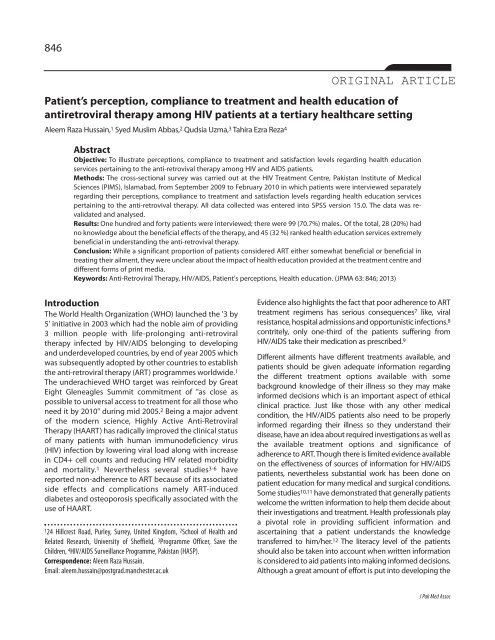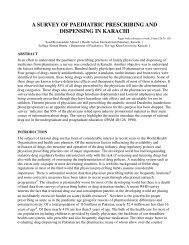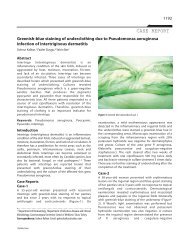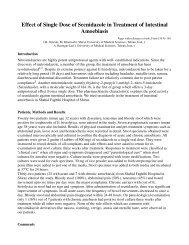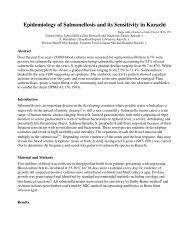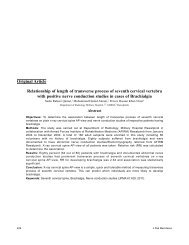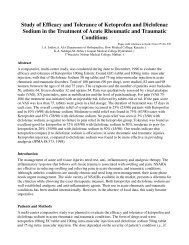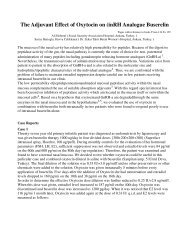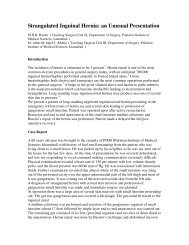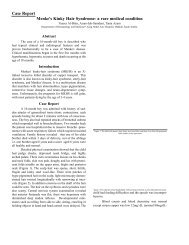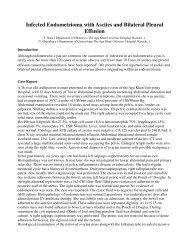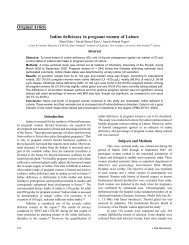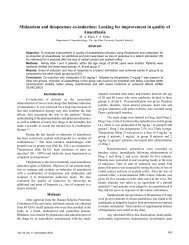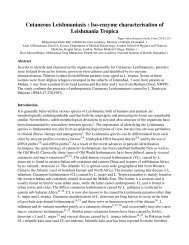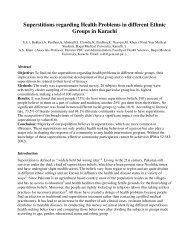ORIGINAL ARTICLE - Journal of Pakistan Medical Association
ORIGINAL ARTICLE - Journal of Pakistan Medical Association
ORIGINAL ARTICLE - Journal of Pakistan Medical Association
Create successful ePaper yourself
Turn your PDF publications into a flip-book with our unique Google optimized e-Paper software.
846<br />
<strong>ORIGINAL</strong> <strong>ARTICLE</strong><br />
Patient’s perception, compliance to treatment and health education <strong>of</strong><br />
antiretroviral therapy among HIV patients at a tertiary healthcare setting<br />
Aleem Raza Hussain, 1 Syed Muslim Abbas, 2 Qudsia Uzma, 3 Tahira Ezra Reza 4<br />
Abstract<br />
Objective: To illustrate perceptions, compliance to treatment and satisfaction levels regarding health education<br />
services pertaining to the anti-retrovival therapy among HIV and AIDS patients.<br />
Methods: The cross-sectional survey was carried out at the HIV Treatment Centre, <strong>Pakistan</strong> Institute <strong>of</strong> <strong>Medical</strong><br />
Sciences (PIMS), Islamabad, from September 2009 to February 2010 in which patients were interviewed separately<br />
regarding their perceptions, compliance to treatment and satisfaction levels regarding health education services<br />
pertaining to the anti-retrovival therapy. All data collected was entered into SPSS version 15.0. The data was revalidated<br />
and analysed.<br />
Results: One hundred and forty patients were interviewed; there were 99 (70.7%) males.. Of the total, 28 (20%) had<br />
no knowledge about the beneficial effects <strong>of</strong> the therapy, and 45 (32 %) ranked health education services extremely<br />
beneficial in understanding the anti-retrovival therapy.<br />
Conclusion: While a significant proportion <strong>of</strong> patients considered ART either somewhat beneficial or beneficial in<br />
treating their ailment, they were unclear about the impact <strong>of</strong> health education provided at the treatment centre and<br />
different forms <strong>of</strong> print media.<br />
Keywords: Anti-Retroviral Therapy, HIV/AIDS, Patient's perceptions, Health education. (JPMA 63: 846; 2013)<br />
Introduction<br />
The World Health Organization (WHO) launched the '3 by<br />
5' initiative in 2003 which had the noble aim <strong>of</strong> providing<br />
3 million people with life-prolonging anti-retroviral<br />
therapy infected by HIV/AIDS belonging to developing<br />
and underdeveloped countries, by end <strong>of</strong> year 2005 which<br />
was subsequently adopted by other countries to establish<br />
the anti-retroviral therapy (ART) programmes worldwide. 1<br />
The underachieved WHO target was reinforced by Great<br />
Eight Gleneagles Summit commitment <strong>of</strong> "as close as<br />
possible to universal access to treatment for all those who<br />
need it by 2010" during mid 2005. 2 Being a major advent<br />
<strong>of</strong> the modern science, Highly Active Anti-Retroviral<br />
Therapy (HAART) has radically improved the clinical status<br />
<strong>of</strong> many patients with human immunodeficiency virus<br />
(HIV) infection by lowering viral load along with increase<br />
in CD4+ cell counts and reducing HIV related morbidity<br />
and mortality. 1 Nevertheless several studies 3-6 have<br />
reported non-adherence to ART because <strong>of</strong> its associated<br />
side effects and complications namely ART-induced<br />
diabetes and osteoporosis specifically associated with the<br />
use <strong>of</strong> HAART.<br />
124 Hillcrest Road, Purley, Surrey, United Kingdom, 2 School <strong>of</strong> Health and<br />
Related Research, University <strong>of</strong> Sheffield, 3 Programme Officer, Save the<br />
Children, 4 HIV/AIDS Surveillance Programme, <strong>Pakistan</strong> (HASP).<br />
Correspondence: Aleem Raza Hussain.<br />
Email: aleem.hussain@postgrad.manchester.ac.uk<br />
Evidence also highlights the fact that poor adherence to ART<br />
treatment regimens has serious consequences 7 like, viral<br />
resistance, hospital admissions and opportunistic infections. 8<br />
contritely, only one-third <strong>of</strong> the patients suffering from<br />
HIV/AIDS take their medication as prescribed. 9<br />
Different ailments have different treatments available, and<br />
patients should be given adequate information regarding<br />
the different treatment options available with some<br />
background knowledge <strong>of</strong> their illness so they may make<br />
informed decisions which is an important aspect <strong>of</strong> ethical<br />
clinical practice. Just like those with any other medical<br />
condition, the HIV/AIDS patients also need to be properly<br />
informed regarding their illness so they understand their<br />
disease, have an idea about required investigations as well as<br />
the available treatment options and significance <strong>of</strong><br />
adherence to ART. Though there is limited evidence available<br />
on the effectiveness <strong>of</strong> sources <strong>of</strong> information for HIV/AIDS<br />
patients, nevertheless substantial work has been done on<br />
patient education for many medical and surgical conditions.<br />
Some studies 10,11 have demonstrated that generally patients<br />
welcome the written information to help them decide about<br />
their investigations and treatment. Health pr<strong>of</strong>essionals play<br />
a pivotal role in providing sufficient information and<br />
ascertaining that a patient understands the knowledge<br />
transferred to him/her. 12 The literacy level <strong>of</strong> the patients<br />
should also be taken into account when written information<br />
is considered to aid patients into making informed decisions.<br />
Although a great amount <strong>of</strong> effort is put into developing the<br />
J Pak Med Assoc
Patient's perception, compliance to treatment and health education <strong>of</strong> antiretroviral therapy... 847<br />
written information material, the design mostly depicts the<br />
health pr<strong>of</strong>essional and/or the manufacturer perspective<br />
and most <strong>of</strong>ten patient perspective and related factors e.g.<br />
social determinants <strong>of</strong> health, including health beliefs,<br />
culture, health literacy level, needs and opinions etc. are<br />
compromised. 13-16 A review 17 has talked about how<br />
patients process written information. The interaction<br />
between the patient and the written material is related as a<br />
symbiotic bond affected by factors such as limited reading<br />
abilities that critically influence the consequent<br />
information processing tasks.<br />
Patient education through several information sources<br />
provided at hospitals or outpatient clinics aim at<br />
encouraging patients` involvement in decisions to<br />
manage their health problems and effective medicinetaking<br />
behaviour 18 by understanding the purpose,<br />
benefits and hazards <strong>of</strong> the medication prescribed. 19 This<br />
eventually intends to enhance compliance with<br />
medication to achieve successful clinical management.<br />
There is paucity <strong>of</strong> data to guide development <strong>of</strong> properly<br />
designed information sources for HIV/AIDS patients on ART<br />
which also facilitate the clinical management. Existing<br />
literature from the developed world is not directly<br />
transferable to resource-limited and culturally-diverse<br />
settings in South East Asia. Furthermore, the incidence <strong>of</strong><br />
HIV AIDS in <strong>Pakistan</strong> has been continuously increasing since<br />
1987, and the total number <strong>of</strong> registered cases had risen to<br />
6000 by 2010. 20 Therefore, it is essential to strengthen the<br />
knowledge base regarding patient education for effective<br />
case management <strong>of</strong> HIV/AIDS patients on ART in the local<br />
context. 21 Considering the imperative role <strong>of</strong> patient<br />
education in clinical management and the goal <strong>of</strong> clinicians<br />
to achieve complete adherence among HIV/AIDS patients<br />
on ART, there is a dire need to examine the sources <strong>of</strong><br />
information for such patients. Under the Enhanced<br />
HIV/AIDS Control Programme <strong>of</strong> the government, HIV/AIDS<br />
patients are being managed at the HIV Treatment Centre,<br />
<strong>Pakistan</strong> institute <strong>of</strong> <strong>Medical</strong> Sciences (PIMS), Islamabad,<br />
since 2003. The information sources for patient education at<br />
this centre are facilitated by counseling, leaflets/brochures<br />
and some posters displayed at the clinic. This study aimed at<br />
exploring patient's perceptions regarding the anti-retroviral<br />
therapy they were receiving, compliance to treatment and<br />
the usefulness <strong>of</strong> the health education provided through<br />
counseling at the HIV Treatment Centre regarding ART<br />
and complications <strong>of</strong> the ailment. The primary objectives<br />
<strong>of</strong> the study were to identify the gaps and illustrate<br />
perceptions regarding ART among the patients and<br />
analyze health education programmes pertaining to ART<br />
and HIV/AIDS, which will eventually positively influence<br />
the long-term goal <strong>of</strong> improving the quality <strong>of</strong> life <strong>of</strong> HIVpositive<br />
people in the country. 22<br />
Patients and Methods<br />
The cross-sectional survey, utilising an interviewadministered<br />
questionnaire, was carried out at the HIV<br />
Treatment Centre, <strong>Pakistan</strong> Institute <strong>of</strong> <strong>Medical</strong> Sciences<br />
(PIMS) Islamabad, during September 2009 and February<br />
2010 in which a total <strong>of</strong> 140 patients were interviewed<br />
separately. The study population consisted <strong>of</strong> HIV/AIDS<br />
cases registered at the treatment centre, since November<br />
2005 onwards. The questionnaire was designed keeping in<br />
mind the internal validity by referring to questionnaires<br />
designed in previous studies 3,23,24 to understand patient's<br />
perception and compliance to treatment with a special<br />
inclusion <strong>of</strong> a section to assess patient's satisfaction and<br />
usefulness <strong>of</strong> health education provided at the centre<br />
pertaining to ART. The questionnaire was also translated<br />
into Urdu and back-translated into English to ensure<br />
validity and atrility to cater to the variances in literacy levels<br />
among patients. The questions included in the<br />
questionnaire were asked in the local language for a better<br />
understanding by patients and to maintain a uniformity <strong>of</strong><br />
information received. The interviews were conducted by a<br />
team <strong>of</strong> two HIV patient counselors, one pharmacist, two<br />
medical <strong>of</strong>ficers and four house <strong>of</strong>ficers. All the interviewers<br />
were trained before conducting the cross-sectional survey<br />
to align their thought processes and understanding <strong>of</strong> the<br />
content <strong>of</strong> the questionnaire to strengthen inter-observer<br />
reliability avoiding measurement bias. The data was<br />
collected on a weekly basis, with alternative shifts between<br />
the interviewers every month and copies <strong>of</strong> filled<br />
questionnaires were collected by the principal investigator<br />
regularly during the research process. The sample size was<br />
calculated using Epi-Info version 6-Statcalc, considering a<br />
population <strong>of</strong> 6000 registered HIV patients at the PIMS<br />
centre. Due to the unknown prevalence <strong>of</strong> disease and to<br />
obtain maximum sample size, 50% prevalence <strong>of</strong> expected<br />
frequency was taken. With accepted 8% difference from the<br />
accepted value, and 95% confidence level, a sample size <strong>of</strong><br />
140 was calculated. Purposive sampling technique was<br />
employed and the sampling frame was registered HIV/AIDS<br />
cases at the treatment centre.<br />
Inclusion criteria stipulated patients to be above 18 years<br />
<strong>of</strong> age <strong>of</strong> either gender, and HIV/AIDS cases registered at<br />
the PIMS treatment centre who were prescribed ART<br />
regimen for at least 3 months. The information collected<br />
in the questionnaires was transferred to the SPSS version<br />
15 manually. The data was re-validated and analysed. All<br />
categorical variables were presented as frequencies and<br />
percentages.<br />
Keeping in mind the ethical considerations, certain<br />
principles were upheld during the process <strong>of</strong> this study<br />
Vol. 63, No. 7, July 2013
848 A. R. Hussain, S. M. Abbas, Q. Uzma, et al.<br />
which included anonymity <strong>of</strong> questionnaires, obtaining<br />
informed verbal consent from patients, achieving ethics<br />
approval from the PIMS Ethics Review Committee.<br />
Results<br />
The total number <strong>of</strong> patients interviewed in the crosssectional<br />
survey was 140. The majority <strong>of</strong> the patients (n=99;<br />
70.7%) were male. The highest number <strong>of</strong> cases was in the<br />
age range <strong>of</strong> 36-45 years (Table). Low literacy levels were<br />
suggestive by the demographic details collected which<br />
depicted graduate level education only in 19 (13.6%) patients.<br />
Majority <strong>of</strong> the patients (n=114; 81.4%) were married.<br />
The second section <strong>of</strong> the questionnaire concentrated on<br />
the patient's perception regarding the beneficial effects<br />
<strong>of</strong> ART prescribed to them. A significant proportion <strong>of</strong><br />
patients (n=100;71.4%) considered ART either somewhat<br />
beneficial or beneficial in treating their ailment, while, 28<br />
(20%) patients had no knowledge about the beneficial<br />
effects <strong>of</strong> ART and a lesser proportion considered it to be<br />
<strong>of</strong> extreme importance (Figure-1).<br />
Figure-1: Patient’s perceptions regarding the beneficial effects <strong>of</strong> Anti-Retroviral<br />
Therapy (n=140).<br />
The third section referred to patient-compliance. A<br />
substantial number <strong>of</strong> patients (n=62; 44.3%) were either<br />
missing out on their medication occasionally or were<br />
irregular in following the treatment regime (Figure-2). The<br />
main reasons reported by patients for low compliance to<br />
treatment were forgetting daily dosage (n=91; 65%) and<br />
its associated side effects (n= 35; 25%).<br />
The fourth section comprised questions assessing the<br />
impact <strong>of</strong> health education provided at the treatment<br />
centre and different forms <strong>of</strong> print media within the<br />
vicinity. The responses received in this section varied as<br />
there was almost an equal distribution <strong>of</strong> opinions, with<br />
Table: Demographic details.<br />
Variable Frequency (n) Percentage (%)<br />
Age <strong>of</strong> the patients<br />
18-25 years 6 4.3%<br />
26-35 years 26 18.6%<br />
36-45 years 66 47.1%<br />
46-55 years 32 22.8%<br />
56-65 years 10 7.1%<br />
Total 140 100%<br />
Gender<br />
Male 99 70.7%<br />
Female 41 29.3%<br />
Educational background<br />
Illiterate 34 24.3%<br />
Primary 22 15.7%<br />
Secondary 65 46.4%<br />
Graduates 19 13.6%<br />
Figure-2: Patient’s compliance to Anti-Retroviral Therapy (n=140).<br />
45 (32%) <strong>of</strong> the patients ranking such services extremely<br />
beneficial, while, 40 (29%) patients considered it to be <strong>of</strong><br />
no use. The remaining 55 (39%) patients were either<br />
unsure or believed that there was room for improvement<br />
and such services could be better delivered.<br />
Discussion<br />
Patient's understanding <strong>of</strong> his/her illness is an important<br />
factor in ascertaining the level <strong>of</strong> self-care practised and<br />
compliance to treatment. Educational background and<br />
previous knowledge can also bridge the gaps <strong>of</strong><br />
communication between the patient and the clinician.<br />
Low literacy levels are reflected in our study, which is<br />
suggesting that the efforts required for better<br />
understanding <strong>of</strong> ART need to be stepped up in<br />
accordance with the understanding capacity <strong>of</strong> the<br />
patients. This suggestion is also substantiated by the<br />
finding in our study in which 20% <strong>of</strong> patients on ART had<br />
no knowledge regarding its use in treating their ailment.<br />
Evidence suggests that poor adherence to ART regimens<br />
J Pak Med Assoc
Patient's perception, compliance to treatment and health education <strong>of</strong> antiretroviral therapy... 849<br />
has serious consequences for HIV-infected patients, 7 for<br />
instance, viral resistance, hospital admissions and<br />
opportunistic infections. 8 Subsequently, in our study a<br />
44.3% (n=62) <strong>of</strong> patients were either missing out on their<br />
medication occasionally or were irregular in following the<br />
treatment regime. This finding has important implications<br />
on the health <strong>of</strong> the patients. Ways and means need to be<br />
explored by which HIV patients could develop a better<br />
understanding <strong>of</strong> their prescriptions and realise the<br />
importance <strong>of</strong> adherence to ART.<br />
Health education can play a pivotal role in bridging gaps<br />
due to low literacy levels among HIV patients by conveying<br />
health messages in a language and medium they could<br />
comprehend and relate to their daily life practice. A<br />
significant number <strong>of</strong> patients acknowledged the health<br />
education services provided at the HIV treatment centre<br />
and believed that it assisted them in understanding ART.<br />
Such services should be better delivered, 25 with some<br />
innovation and feedback from the patients.<br />
Conclusion<br />
In this study we found that while a significant proportion<br />
<strong>of</strong> patients considered ART either somewhat beneficial or<br />
beneficial in treating their ailment, they were unclear<br />
about the impact <strong>of</strong> health education provided at the<br />
treatment centre and different forms <strong>of</strong> print media.<br />
Patient's perceptions and compliance to treatment are<br />
important indicators to assess the effectiveness <strong>of</strong> ART<br />
and its acceptability among HIV/AIDS-positive patients.<br />
ART has beneficial effects on the lives <strong>of</strong> HIV patients, but<br />
at the cost <strong>of</strong> its associated side effects and lifelong intake.<br />
Patient's perception and compliance to treatment are<br />
important to understand to assess the effectiveness <strong>of</strong><br />
this treatment regime and its acceptability among HIVpositive<br />
patients. Health Education at HIV treatment<br />
centres can prove to be a useful tool to bridge gaps in<br />
patient-clinician communications. Counsellors need to be<br />
better trained to cope with different literacy levels <strong>of</strong><br />
patients by incorporating innovative ways and means.<br />
References<br />
1. HIV/AIDS Department <strong>of</strong> WHO. The 3 by 5 Initiative: Treat Three<br />
Million People with HIV/AIDS by 2005. (Online) 2011 (Cited 2011<br />
March 12). Available from URL: http://www.who.int/3by5/en/.<br />
2. Hardon A, Davey S, Gerrits T, Hodgkin C, Irunde H, Kgatlwane J, et<br />
al (eds.). From access to adherence: the challenges <strong>of</strong> antiretroviral<br />
treatment. Studies from Botswana, Tanzania and Uganda. Geneva:<br />
WHO Press; 2006.<br />
3. Olowookere SA, Fatiregun AA, Akinyemi JO, Bamgboye AE,<br />
Osagbemi GK. Prevalence and determinants <strong>of</strong> nonadherence to<br />
highly active antiretroviral therapy among people living with<br />
HIV/AIDS in Ibadan, Nigeria. J Infect Dev Ctries 2008; 2: 369-72.<br />
4. Yasuoka A. Challenges <strong>of</strong> the anti-retroviral therapy. Nippon<br />
Rinsho 2002; 60: 750-6.<br />
5. Bakari AG, Sani-Bello F, Shehu MS, Mai A, Aliyu IS, Lawal II. Anti-retroviral<br />
therapy induced diabetes in a Nigerian. Afr Health Sci 2007; 7: 133-5.<br />
6. Pan G, Yang Z, Ballinger SW, McDonald JM. Pathogenesis <strong>of</strong><br />
osteopenia/osteoporosis induced by highly active anti-retroviral<br />
therapy for AIDS. Ann N Y Acad Sci 2006; 1068: 297-308.<br />
7. Turner BJ. Adherence to antiretroviral therapy by human<br />
immunodeficiency virus-infected patients. J Infect Dis 2002; 185<br />
(Suppl 2): S143-51.<br />
8. Paterson DL, Swindells S, Mohr J, Brester M, Vergis EN, Squier C, et<br />
al. Adherence to protease inhibitor therapy and outcomes in<br />
patients with HIV infection. Ann Intern Med 2000; 133: 21-30.<br />
9. Bedell SE, Jabbour S, Goldberg R, Glaser H, Gobble S, Young-Xu Y, et al.<br />
Discrepancies in the use <strong>of</strong> medications: their extent and predictors in<br />
an outpatient practice. Arch Intern Med 2000; 160: 2129-34.<br />
10. Coudeyre E, Poiraudeau S, Reve M, Kahan A, Drapé JL, Ravaud P.<br />
Beneficial effects <strong>of</strong> information leaflets before spinal steroid<br />
injection. Joint Bone Spine 2002; 69: 597-603.<br />
11. Rogstad KE, Bramham L, Lowbury R, Kinghorn GR. Use <strong>of</strong> a leaflet<br />
to replace verbal pretest discussion for HIV: effects and<br />
acceptability. Sex Transm Infect 2003; 79: 243-5.<br />
12. Ley P. Communicating with patients: improving communication,<br />
satisfaction and compliance. London: Chapman and Hall, 1988.<br />
13. Koo MM, Krass I, Aslani P. Patient characteristics influencing<br />
evaluation <strong>of</strong> written medicine information: lessons for patient<br />
education. Ann Pharmacother 2005; 39: 1434-40.<br />
14. Mansoor L, Dowse R. Effect <strong>of</strong> pictograms on readability <strong>of</strong> patient<br />
information materials. Ann Pharmacother 2003; 37: 1003-9.<br />
15. Schaafsma ES, Raynor DK, de Jong-van den Berg LTW. Accessing<br />
medication information by ethnic minorities: barriers and<br />
possible solutions. Pharm World Sci 2003; 25: 185-90.<br />
16. Buck ML. Providing patients with written medication information.<br />
Ann Pharmacother 1998; 32: 962-9.<br />
17. Morris LA, Aikin KJ. The pharmacokinetics <strong>of</strong> patient<br />
communications. Drug Inf J 2001; 35: 509-27.<br />
18. Coulter A. Evidence based patient information is important, so there<br />
needs to be a national strategy to ensure it. BMJ 1998; 317: 225-6.<br />
19. Gustafsson J, Kälvermark S, Nilsson G, Nilsson JL. Patient information<br />
leaflets — patients’ comprehension <strong>of</strong> information about<br />
interactions and contraindications. Pharm World Sci 2005; 27: 35-40.<br />
20. Ilyas M, Asad S, Ali L, Shah M, Badar S, Sarwar MT, et al. A<br />
situational analysis <strong>of</strong> HIV and AIDS in <strong>Pakistan</strong>. Virol J. 2011; 8:<br />
191. doi: 10.1186/1743-422X-8-191.<br />
21. Farid-ul-Hasnain S, Johansson E, Krantz G. What do young adults<br />
know about the HIV/AIDS epidemic? Findings from a population<br />
based study in Karachi, <strong>Pakistan</strong>. BMC Infect Dis 2009; 9: 38.<br />
doi:10.1186/1471-2334-9-38.<br />
22. Rai MA, Rajabali A, Khan MN, Khan MA, Ali SH. Educating the<br />
power: HIV/AIDS and parliamentarians <strong>of</strong> <strong>Pakistan</strong>. Health Res<br />
Policy Syst 2009; 7: 20. doi: 10.1186/1478-4505-7-20.<br />
23. Ramírez García P, Côté JK. Factors affecting adherence to<br />
antiretroviral therapy in people living with HIV/AIDS. J Assoc<br />
Nurses AIDS Care 2003; 14: 37-45.<br />
24. Kalichman SC, Grebler T. Stress and poverty predictors <strong>of</strong><br />
treatment adherence among people with low-literacy living with<br />
HIV/AIDS. Psychosom Med 2010; 72: 810-6.<br />
25. Khan MS, Unemo M, Zaman S, Lundborg CS. Knowledge, attitudes<br />
and practices regarding human immunodeficiency virus/acquired<br />
immune deficiency syndrome and sexually transmitted infections<br />
among health care providers in Lahore, <strong>Pakistan</strong>. J Ayub Med Coll<br />
Abbottabad 2009; 21: 1-6.<br />
Vol. 63, No. 7, July 2013


